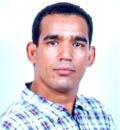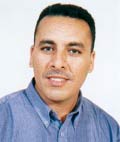Contents: 2024 | 2023 | 2022 | 2021 | 2020 | 2019 | 2018 | 2017 | 2016 | 2015 | 2014 | 2013 | 2012 | 2011 | 2010 | 2009 | 2008 | 2007 | 2006 | 2005 | 2004 | 2003 | 2002 | 2001
2003, 1
Using Stationary Wavelet Transform in BCH Image Coding
language: English
received 19.10.2002, published 20.01.2003
Download article (PDF, 200 kb, ZIP), use browser command "Save Target As..."
To read this document you need Adobe Acrobat © Reader software, which is simple to use and available at no cost. Use version 4.0 or higher. You can download software from Adobe site (http://www.adobe.com/).
ABSTRACT
This paper propose a novel technique that use efficient image compression based on stationary wavelet transform (SWT) decomposition and Bose-Chauhuri-Hochquenghem (BCH) coding for image transmission over additive white Gaussian noise (AWGN) channel. We know that, discrete wavelet transform (DWT) decomposition suffers a drawback which is the not time-invariant transform, leading to a non-redundant decomposition. This means, even with periodic signal extension, the DWT of a translated version of a signal X is not, in general, the translated version of the DWT of X. In such case, the use of an adequate wavelet transform that restore the translation invariance, appear efficient to give high-quality image reconstruction. Also, BCH coding is a linear block procedure that permits multiple-error bit correction over noisy channel. The idea is to combine efficient image compression gived by SWT decomposition with an exam of the selection of the Bose-Chauhuri-Hochquenghem (BCH) error correction codes applied to the low pass version at different decomposition level. By using BCH(63,45,3) code against the channel degradation, a significal improvement is obtained.
8 pages, 6 figures
Сitation: A. Seddiki, A. Djebbari, J. M. Rouvaen. Using Stationary Wavelet Transform in BCH Image Coding. Electronic Journal “Technical Acoustics”, http://www.ejta.org, 2003, 1.
REFERENCES
[1] C. S. Burrus, R A. Gopinath, H. Guo. Introduction to wavelets and Wavelet Transform. Prentice-hall International, Inc, New Jersey, 1998.
[2] N. Matoba, S. Yoshida. Still image transmission using un-equal error protection coding in mobile radio channel. Electron. Comm. Japan 1, Commun., 79 (4), 75–85, April 1996.
[3] C. W. Yap, K. N. Ngan, R. Liyanapathirana. Error protection scheme for the transmission of H.263 coded video over mobile radio channels. Proc. SPIE, vol. 3024, part 2, 1997, pp. 1241–1249.
[4] C. Berrou, A. Glavieux, and P. Thitimajshima. Nera Shanon limit error correcting coding and decoding: Turbo codes”. In IEEE Int. Conf. on Communications, pp. 1064–1070, 1993.
[5] P. Abry. Ondelettes et turbulence. Multiresolutions, algorithmes de decomposition, invariance d’echelles. Diderot Editeur, Paris, 1997.
[6] R. K. Young. Wavelets Theory and its Applications. Kluwer Academic Publishers, Boston, 1993.
[7] I. Daubechies. Orthonormal Bases of Compactly Supported Wavelets. Comm. Pure and Applied Mathematics, vol. 41, no. 7, pp. 909–996, 1988.
[8] S. Mallat. A Theory of Multiresolution Signal Decomposition: The Wavelet Representation. IEEE Trans. Pattern Analysis and Machine Intelligence, vol. 11, pp. 674–693, 1989.
[9] S. Mallat. A Wavelet Tour of Signal Processing. Academic press, San Diego, 1988.
[10] N. Moreau. Technique de compression des signaux. Masson, Paris, Milan, Barcelone, 1995.
[11] R. Stedman, H. Gharavi, L. Hanzo, R. Steele. Transmission of subband-coded images via mobile channels. IEEE Trans. Circuits Systems for Video Tech., 3 (1), Feb., 1993.
 |
Seddiki Ali was born in Bechar, Algeria. He received the Dipl.El.-Ing. degree, the Master degree, from the University of Djillali- Liabes of Sidi-Bel-Abbes, Algeria, respectively in 1994, 1997, and actually preparing the doctorat thesis. Since 1997, he is an assistant professor at the Dept. of Electronics of the University of Sidi-Bel-Abbes, and a scientist researcher in Telecommunication and Digital Signal Processing Laboratory. His research interests include image processing applications, wavelet transforms, source coding, and image reconstruction algorithms. |
|
 |
Djebbari Ali was born in Sidi Lahcen (Sidi Bel Abbes), Algeria. He received the Dipl.El.-Ing. degree from USTO (ORAN, Algeria) in 1988, the Master degree from Sidi Bel Abbes University in 1991, and the Doctorat es Science degree from USTO (ORAN, Algeria) in 1997. Since 1991, he is on the Dept of Electronics at the University of Sidi Bel Abbes. Currently he is a scientist director of the Telecommunication and Digital Signal Processing Laboratory. His Research interests include wireless networks, signal processing for telecommunications, communication over multipath and fading channel, Orthogonal Multi-Carrier CDMA, Wide band CDMA, Channel coding for telecommunications. |
|
 |
J. M. Rouvaen was born in 1947, France. He received the Doctorat es Science degree from University of Paris VI in 1976. Currently, he is a Professor of Electronics at ENSI of mechanical energetic, Valenciennes. His Research interests include applications of signal processing for telecommunications, ultrasounds, and radar. |
|
